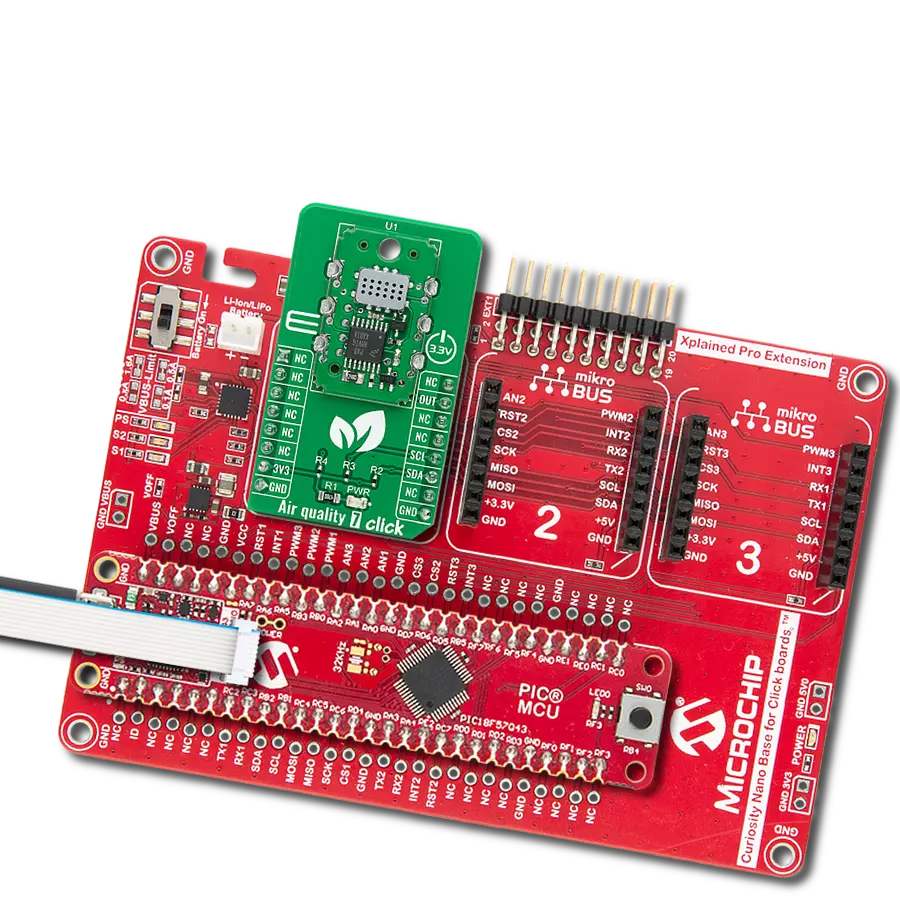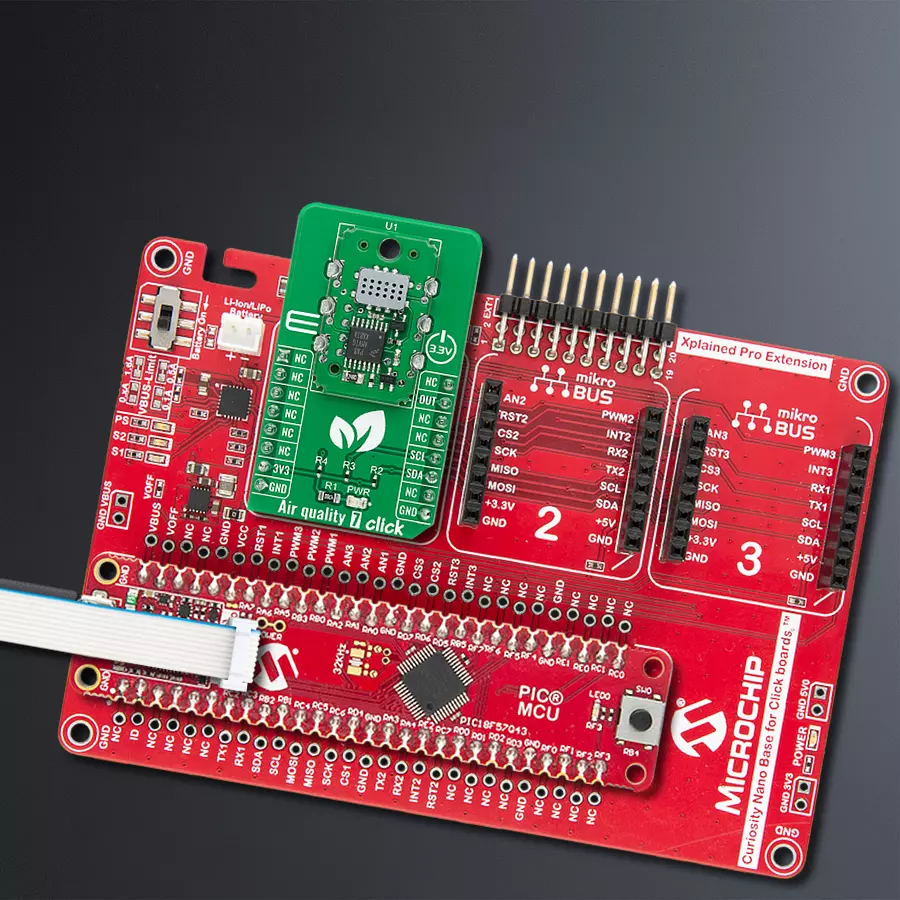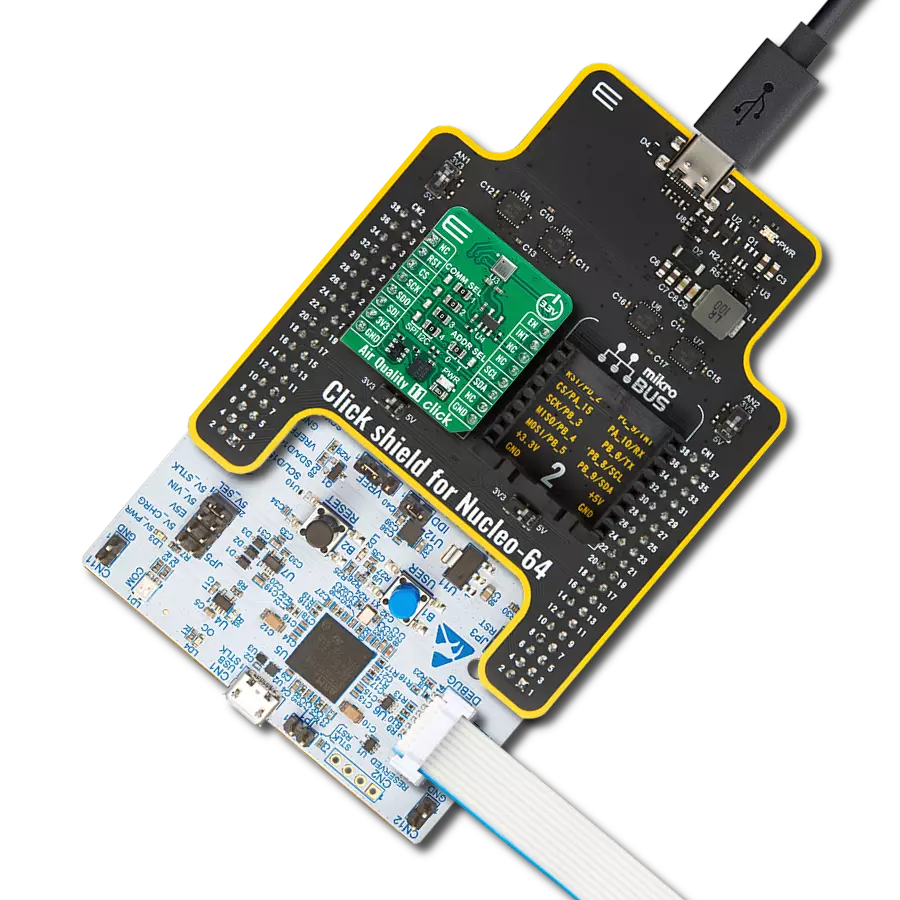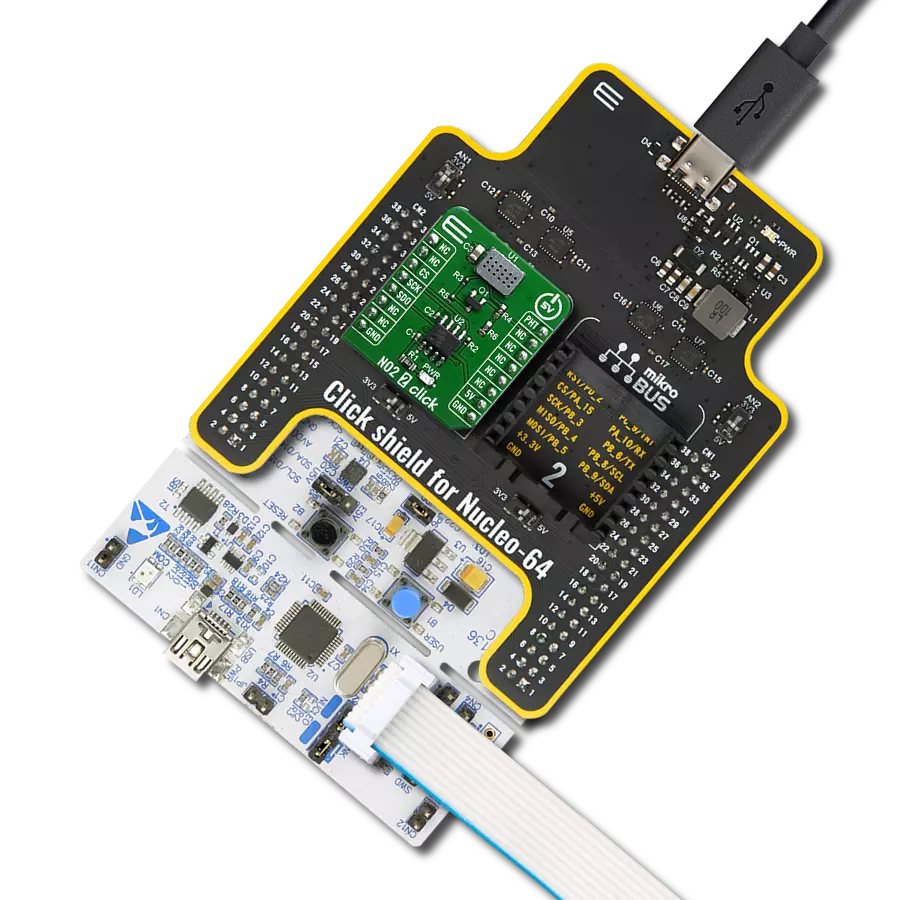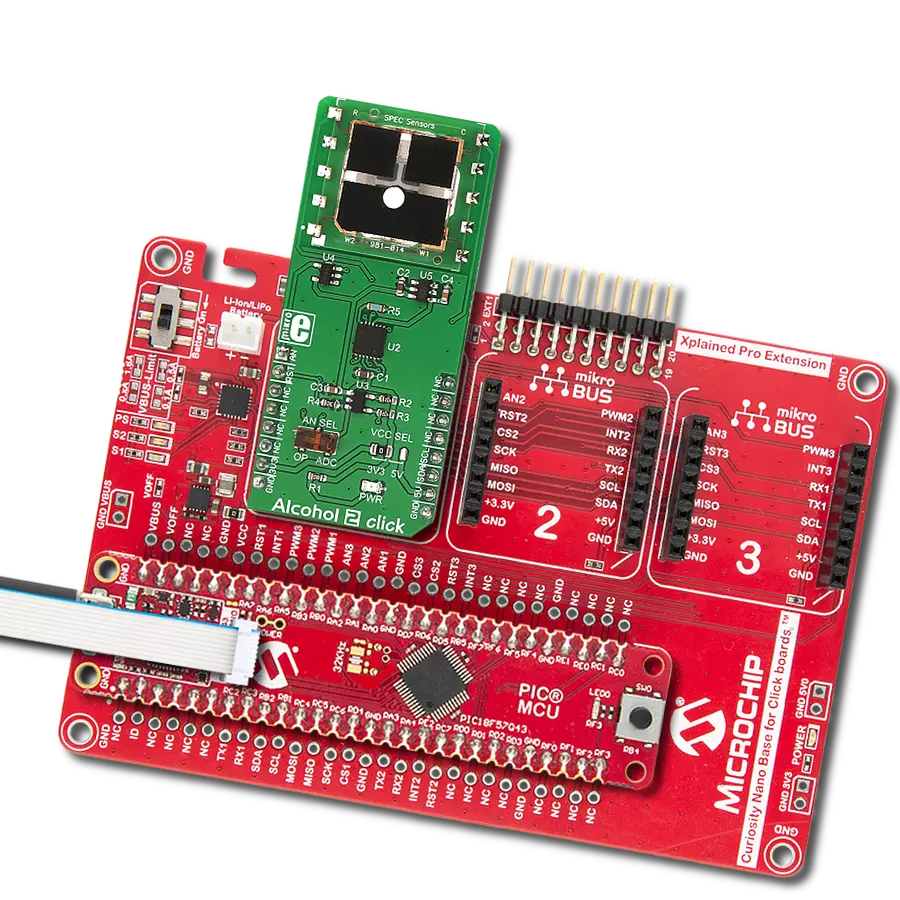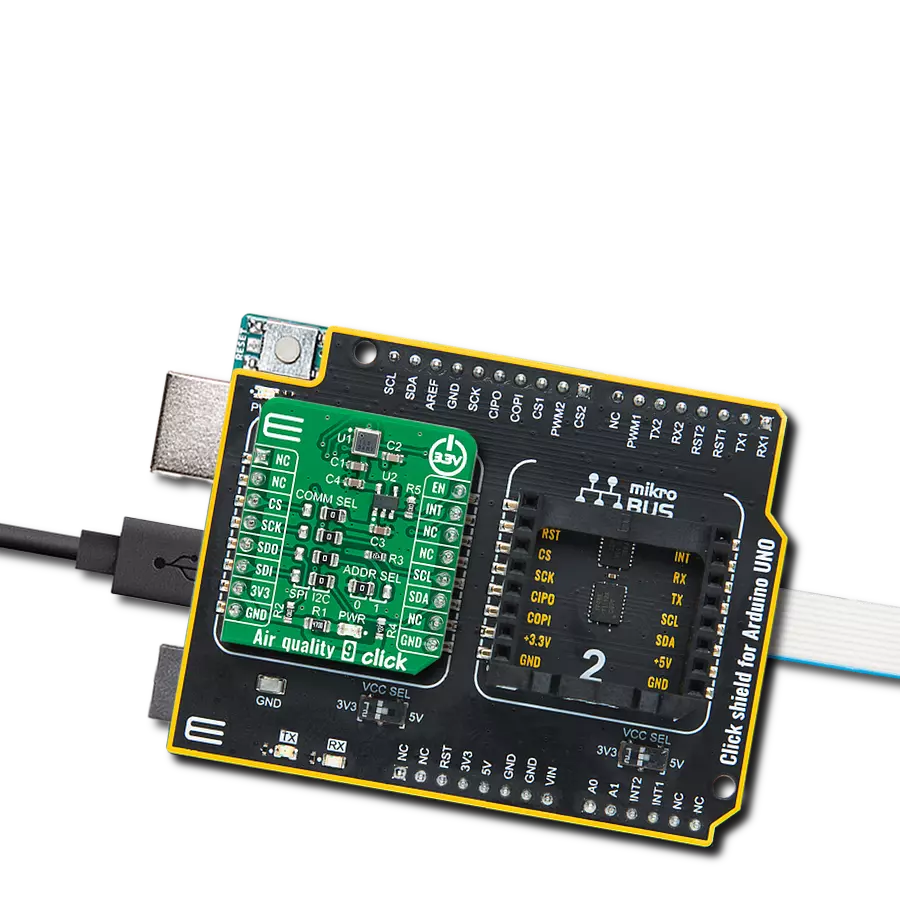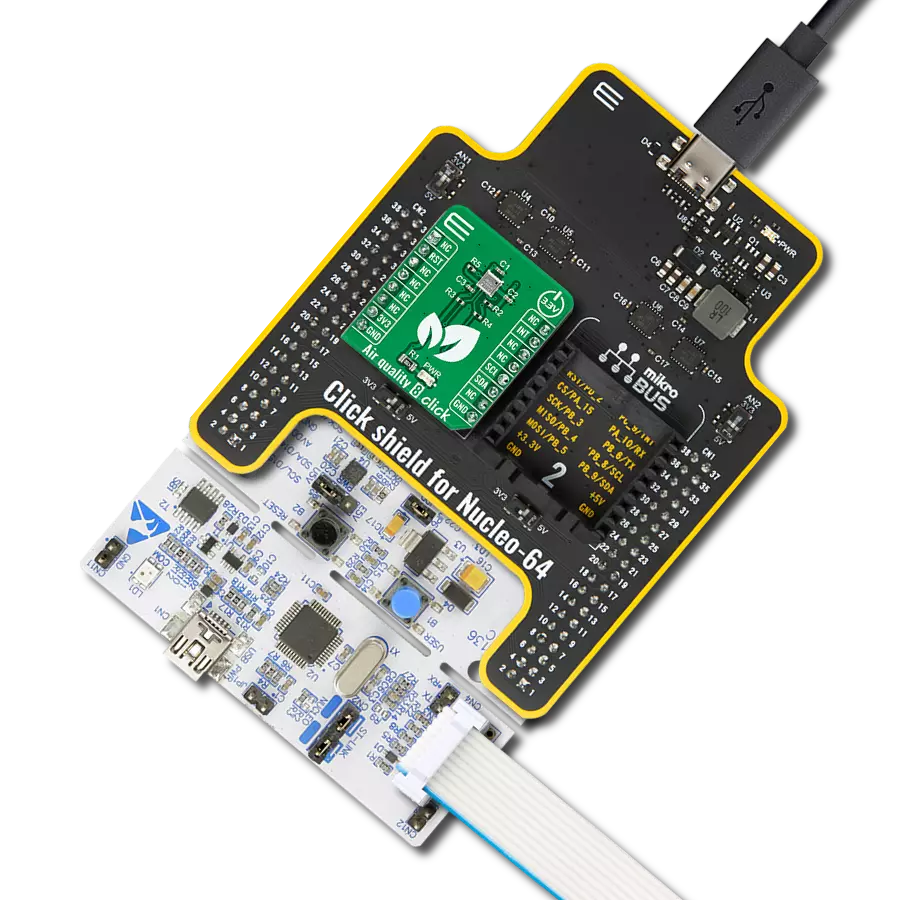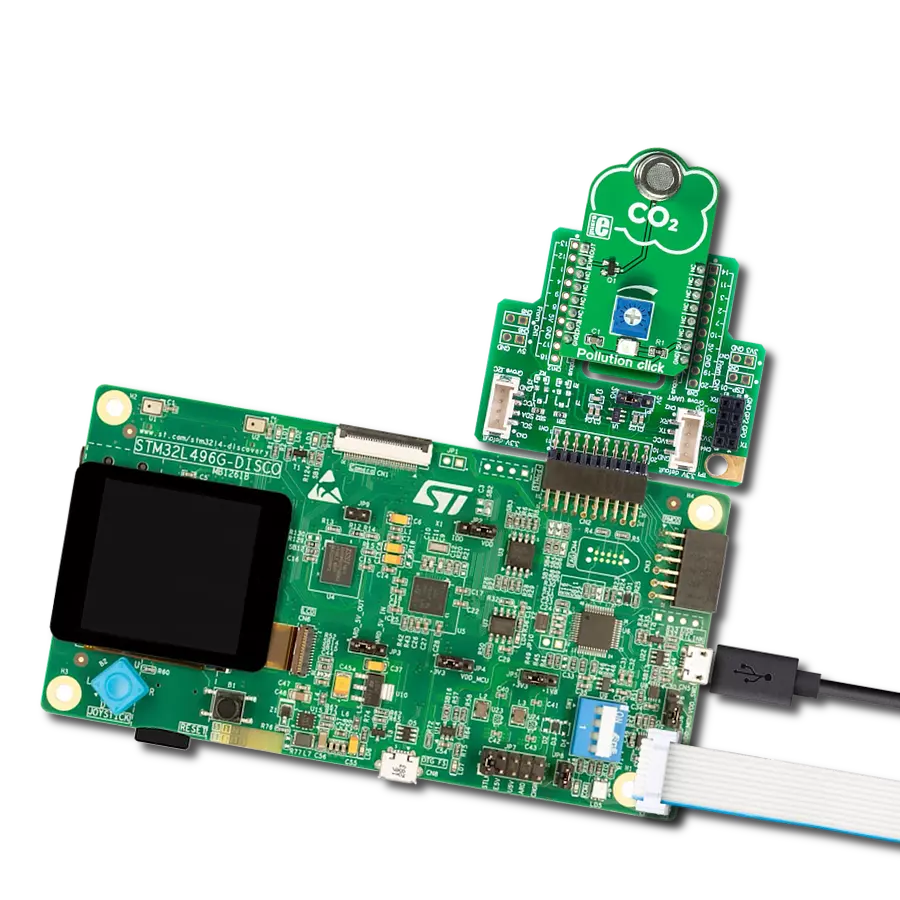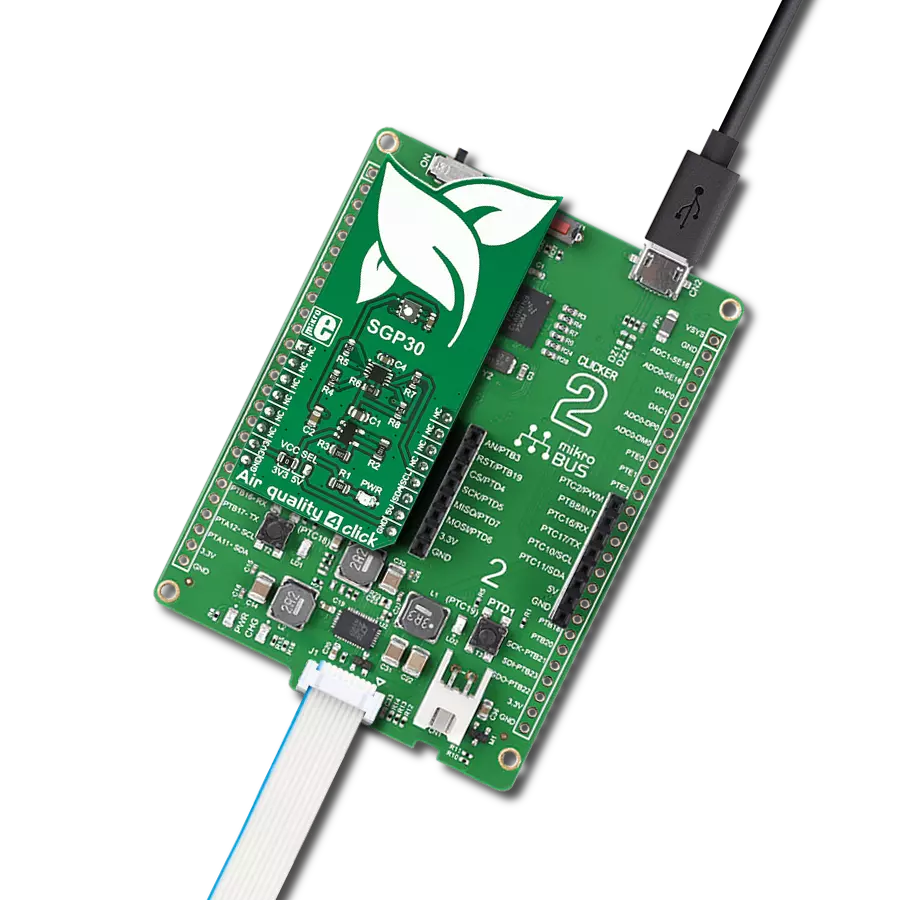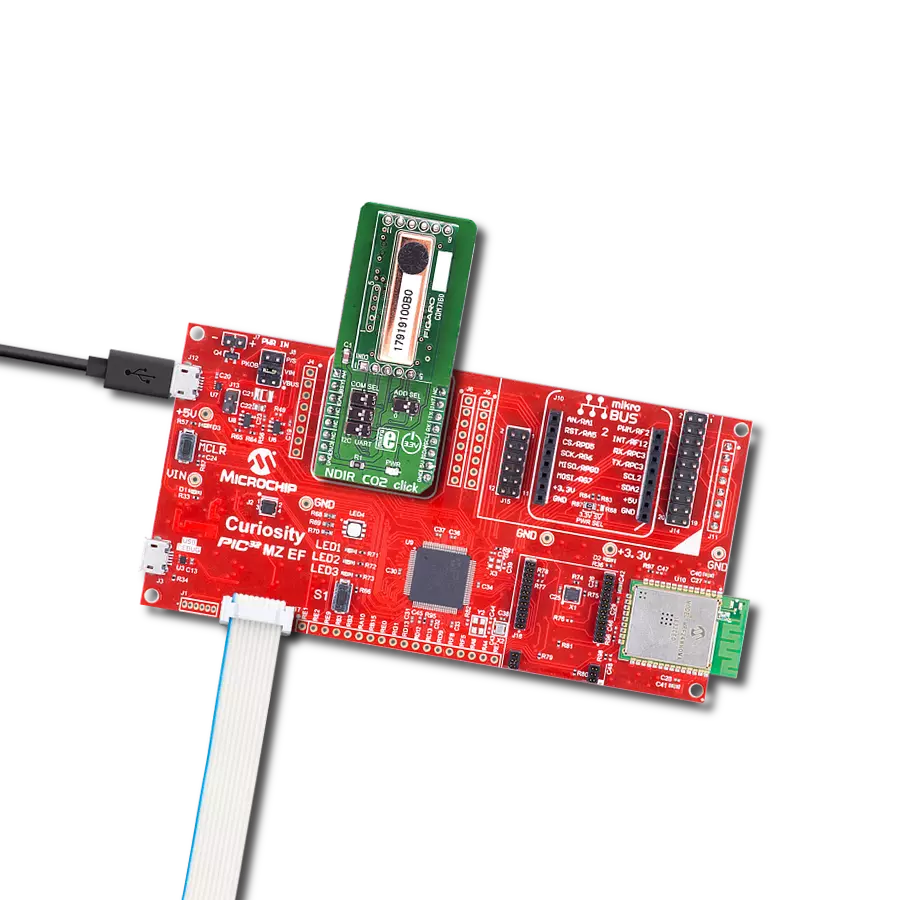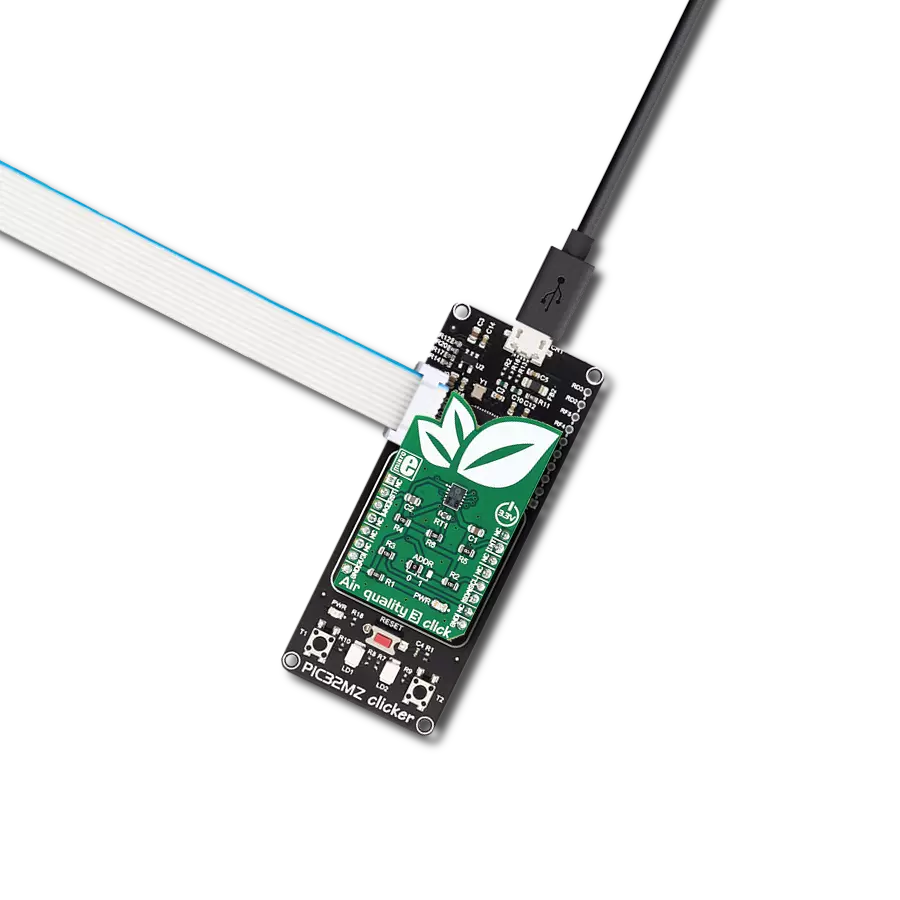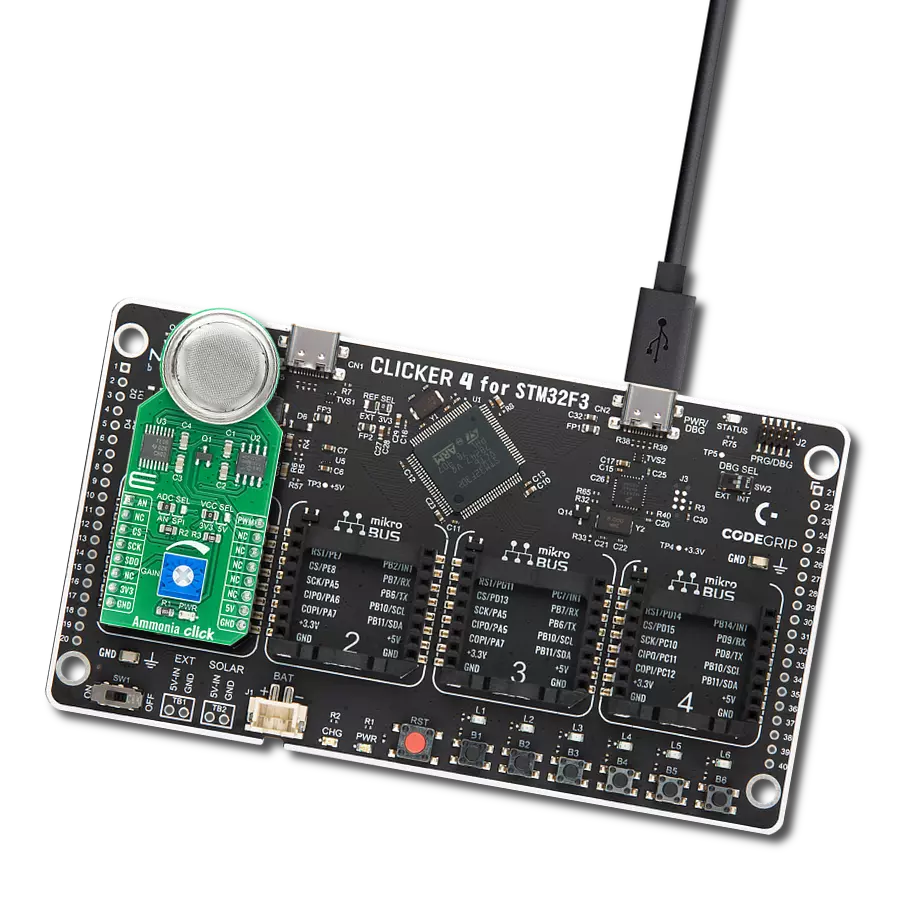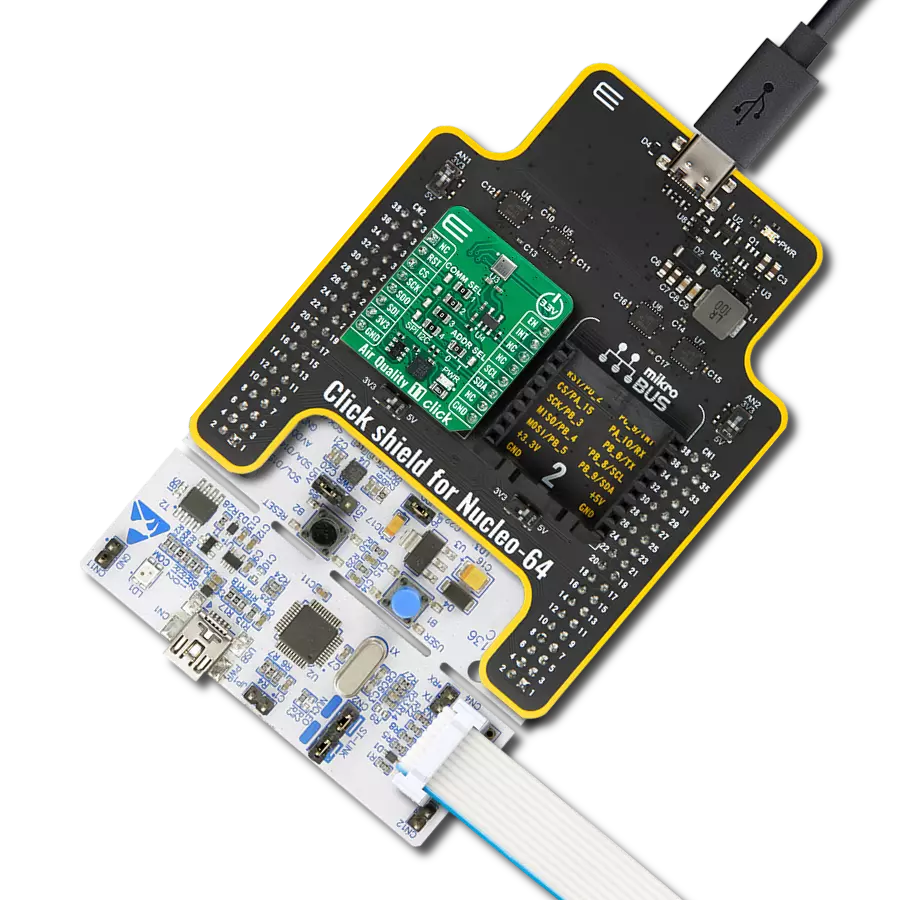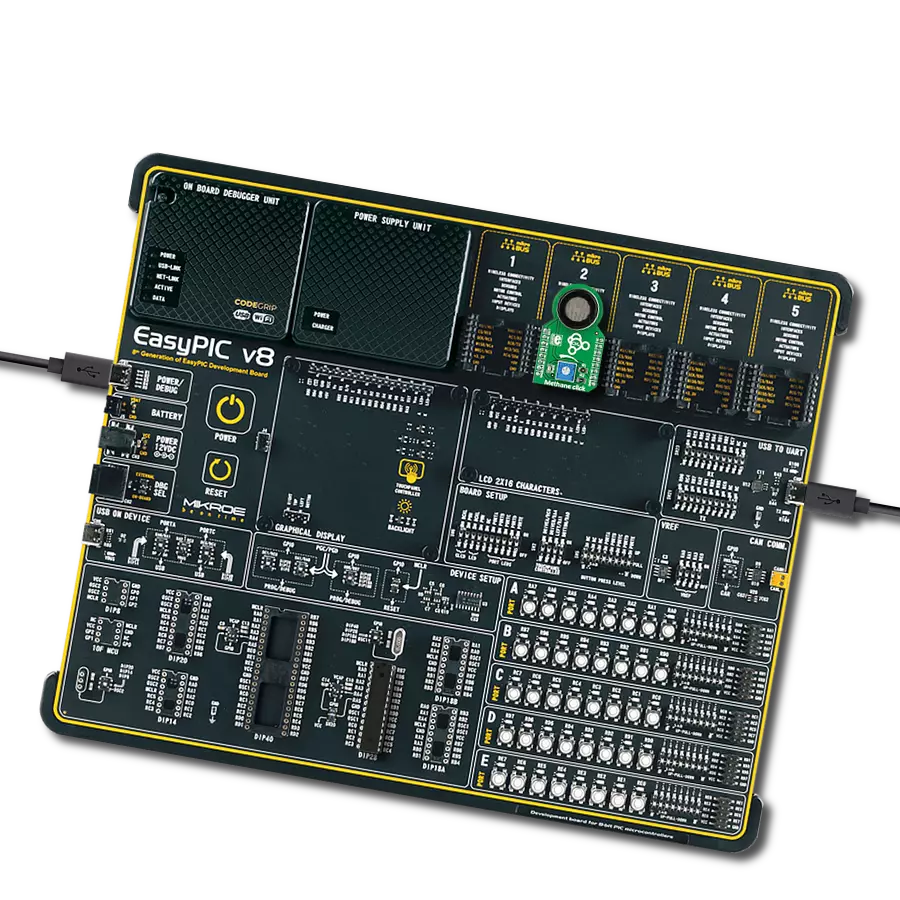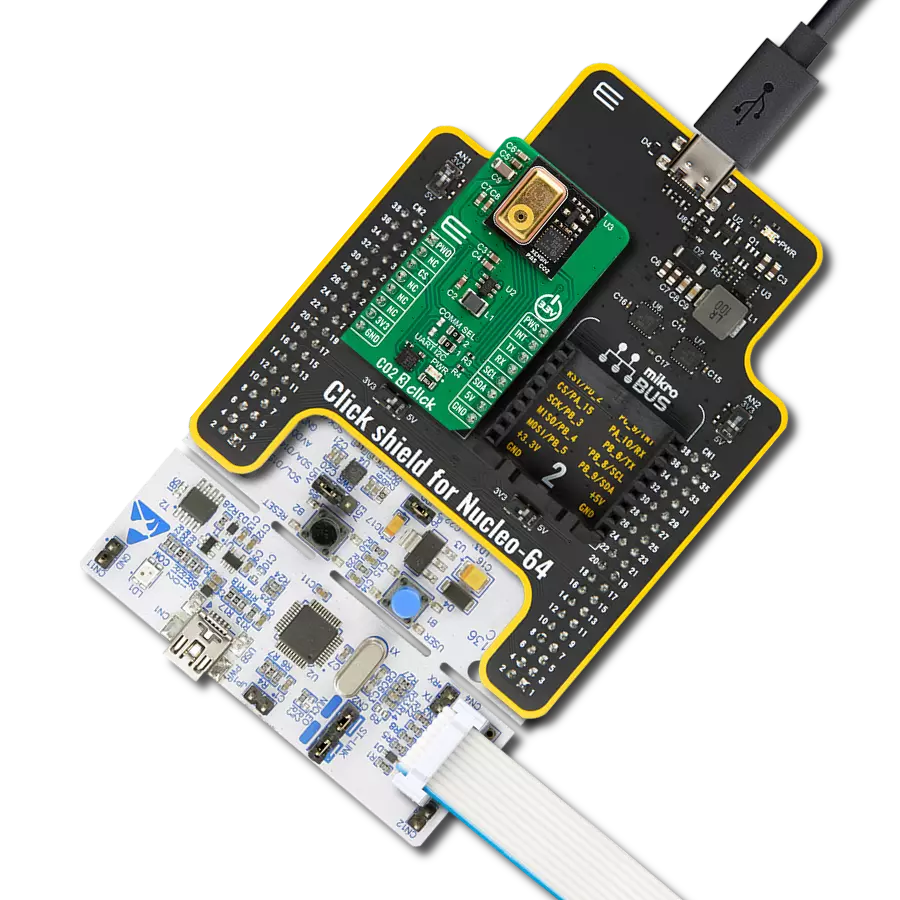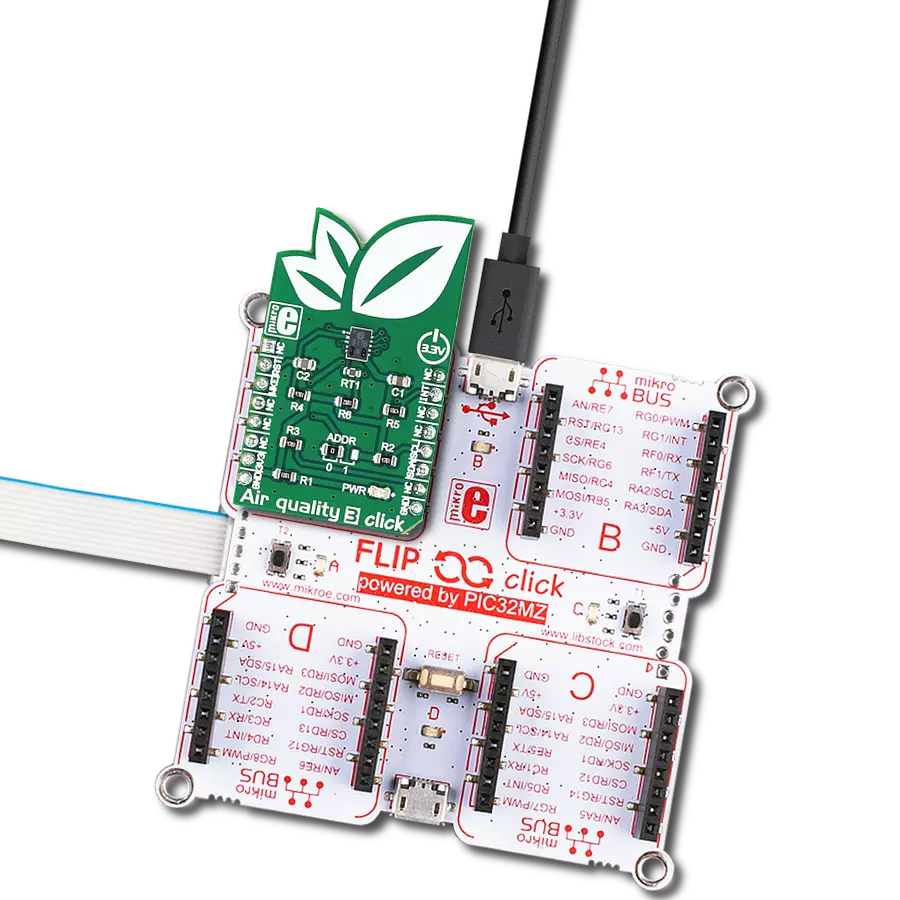Our comprehensive air quality monitoring solution empowers individuals, businesses, and communities with accurate data to make informed decisions for healthier surroundings.
A
A
Hardware Overview
How does it work?
Air Quality 7 Click is based on the MiCS-VZ-89TE, an integrated sensor module from Amphenol for indoor air quality monitoring. The MiCS-VZ-89TE combines the most modern MOS sensor technology with intelligent detection algorithms to control VOCs and CO2 fluctuations in buildings. Among other appealing features like 3.3V supply, I2C communication, and calibration-free high sensitivity, this module has a small size factor. The sensor must not be exposed to high concentrations of organic solvents, ammonia, silicone vapor, or cigarette smoke to avoid poisoning the sensitive layer. It should be protected against water and dust projections, and its Vendor strongly recommends using ESD protection equipment to handle the sensor. This Click board™ is easy to program and read data because it does not require an overly demanding configuration. The first step is the initialization of
all the necessary peripherals and pins. The additional delay time of a couple of seconds during system initialization is needed because this Click board™ needs some time to establish the measurements. The second initialization is the I2C driver and communication test by reading the revision information of the module. If the CRC check is OK, it allows the program to go on; if it's not, a user needs to restart the program. The user can read the air quality status if every step is valid. This can also be seen in an example code that contains easy-to-use functions that may be used as a reference for further development. Air quality 7 Click communicates with MCU using the standard I2C 2-Wire interface that supports Standard-Mode operation with bit rates up to 100 kbit/s. The MiCS-VZ-89TE slave address contains seven fixed bits. The slave address byte is the first byte received following the START condition from
the host device. The first part of the address byte consists of a 4-bit device code, which is set to 1110 for the IAQS, followed by three address bits (A2, A1, A0), which are programmed at 0. The dual signal output routed on the OUT pin of the mikroBUS™ socket, which brings the results of the measurements, can be read through a multiplexed PWM output or an I2C bus. This Click board™ is designed to be operated only with a 3.3V logic voltage level. A proper logic voltage level conversion should be performed before the Click board™ is used with MCUs with different logic voltage levels. More information about the MiCS-VZ-89TE can be found in the attached datasheet. However, the Click board™ comes equipped with a library that contains easy-to-use functions and a usage example that may be used as a reference for further development.
Features overview
Development board
PIC18F57Q43 Curiosity Nano evaluation kit is a cutting-edge hardware platform designed to evaluate microcontrollers within the PIC18-Q43 family. Central to its design is the inclusion of the powerful PIC18F57Q43 microcontroller (MCU), offering advanced functionalities and robust performance. Key features of this evaluation kit include a yellow user LED and a responsive
mechanical user switch, providing seamless interaction and testing. The provision for a 32.768kHz crystal footprint ensures precision timing capabilities. With an onboard debugger boasting a green power and status LED, programming and debugging become intuitive and efficient. Further enhancing its utility is the Virtual serial port (CDC) and a debug GPIO channel (DGI
GPIO), offering extensive connectivity options. Powered via USB, this kit boasts an adjustable target voltage feature facilitated by the MIC5353 LDO regulator, ensuring stable operation with an output voltage ranging from 1.8V to 5.1V, with a maximum output current of 500mA, subject to ambient temperature and voltage constraints.
Microcontroller Overview
MCU Card / MCU
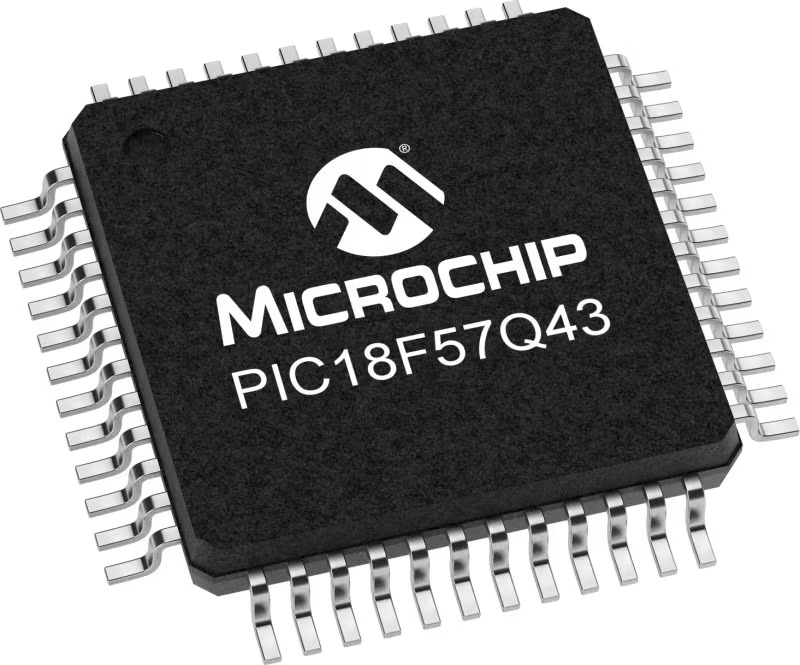
Architecture
PIC
MCU Memory (KB)
128
Silicon Vendor
Microchip
Pin count
48
RAM (Bytes)
8196
You complete me!
Accessories
Curiosity Nano Base for Click boards is a versatile hardware extension platform created to streamline the integration between Curiosity Nano kits and extension boards, tailored explicitly for the mikroBUS™-standardized Click boards and Xplained Pro extension boards. This innovative base board (shield) offers seamless connectivity and expansion possibilities, simplifying experimentation and development. Key features include USB power compatibility from the Curiosity Nano kit, alongside an alternative external power input option for enhanced flexibility. The onboard Li-Ion/LiPo charger and management circuit ensure smooth operation for battery-powered applications, simplifying usage and management. Moreover, the base incorporates a fixed 3.3V PSU dedicated to target and mikroBUS™ power rails, alongside a fixed 5.0V boost converter catering to 5V power rails of mikroBUS™ sockets, providing stable power delivery for various connected devices.
Used MCU Pins
mikroBUS™ mapper
Take a closer look
Click board™ Schematic

Step by step
Project assembly
Software Support
Library Description
This library contains API for Air Quality 7 Click driver.
Key functions:
airquality7_get_status- Get Status functionairquality7_get_revision- Get Revision functionairquality7_get_r0_calib- Get R0 Calibration function.
Open Source
Code example
The complete application code and a ready-to-use project are available through the NECTO Studio Package Manager for direct installation in the NECTO Studio. The application code can also be found on the MIKROE GitHub account.
/*!
* \file
* \brief AirQuality7 Click example
*
* # Description
* This demo application measures air quality.
*
* The demo application is composed of two sections :
*
* ## Application Init
* Initializes I2C driver and reads revision date of the module.
* If CRC check is OK allows the program to go on, otherwise, it displays a message that
* the program needs to be restarted.
*
* ## Application Task
* Reads air quality status every 1500ms and shows the results on the USB UART.
*
* \author MikroE Team
*
*/
// ------------------------------------------------------------------- INCLUDES
#include "board.h"
#include "log.h"
#include "airquality7.h"
// ------------------------------------------------------------------ VARIABLES
static airquality7_t airquality7;
static log_t logger;
uint16_t airquality7_tvoc_ppb;
uint16_t airquality7_co2_ppm;
uint32_t airquality7_res_val_ohm;
airquality7_err_t airquality7_err_code;
// ------------------------------------------------------ APPLICATION FUNCTIONS
void application_init ( void )
{
log_cfg_t log_cfg;
airquality7_cfg_t cfg;
uint8_t airquality7_rev_year = AIRQUALITY7_DUMMY;
uint8_t airquality7_rev_month = AIRQUALITY7_DUMMY;
uint8_t airquality7_rev_day = AIRQUALITY7_DUMMY;
uint8_t airquality7_rev_ascii_code = AIRQUALITY7_DUMMY;
/**
* Logger initialization.
* Default baud rate: 115200
* Default log level: LOG_LEVEL_DEBUG
* @note If USB_UART_RX and USB_UART_TX
* are defined as HAL_PIN_NC, you will
* need to define them manually for log to work.
* See @b LOG_MAP_USB_UART macro definition for detailed explanation.
*/
LOG_MAP_USB_UART( log_cfg );
log_init( &logger, &log_cfg );
log_info( &logger, "---- Application Init ----" );
// Click initialization.
airquality7_cfg_setup( &cfg );
AIRQUALITY7_MAP_MIKROBUS( cfg, MIKROBUS_1 );
airquality7_init( &airquality7, &cfg );
airquality7_tvoc_ppb = AIRQUALITY7_DUMMY;
airquality7_co2_ppm = AIRQUALITY7_DUMMY;
airquality7_res_val_ohm = AIRQUALITY7_DUMMY;
airquality7_err_code = airquality7_get_revision( &airquality7,
&airquality7_rev_year,
&airquality7_rev_month,
&airquality7_rev_day,
&airquality7_rev_ascii_code );
if ( airquality7_err_code == AIRQUALITY7_ERR_OK )
{
log_printf( &logger, " Revision date: %.2u.%.2u.%.2u\r\n", ( uint16_t ) airquality7_rev_day,
( uint16_t ) airquality7_rev_month,
( uint16_t ) airquality7_rev_year );
log_printf( &logger, " ASCII code for a charter: %u \r\n", ( uint16_t ) airquality7_rev_ascii_code );
}
else
{
log_printf( &logger, "CRC ERROR READING REVISION. \r\n" );
Delay_ms ( 1000 );
for ( ; ; )
{
log_printf( &logger, "PLEASE, RESTART YOUR SYSTEM...\r\n" );
Delay_ms ( 1000 );
log_printf( &logger, " \r\n \r\n " );
Delay_ms ( 1000 );
}
}
log_printf( &logger, "----------------------------------------- \r\n" );
Delay_ms ( 500 );
}
void application_task ( void )
{
airquality7_err_code = airquality7_get_status( &airquality7,
&airquality7_tvoc_ppb,
&airquality7_co2_ppm,
&airquality7_res_val_ohm,
AIRQUALITY7_NULL );
if ( airquality7_err_code == AIRQUALITY7_ERR_OK )
{
uint8_t cnt;
log_printf( &logger, " tVOC [ppb] = %u \r\n", airquality7_tvoc_ppb );
log_printf( &logger, " CO2 [ppm] = %u \r\n", airquality7_co2_ppm );
log_printf( &logger, " Resistor value [ohm] = %lu \r\n", airquality7_res_val_ohm );
log_printf( &logger, "----------------------------------------- \r\n" );
}
Delay_ms ( 1000 );
Delay_ms ( 500 );
}
int main ( void )
{
/* Do not remove this line or clock might not be set correctly. */
#ifdef PREINIT_SUPPORTED
preinit();
#endif
application_init( );
for ( ; ; )
{
application_task( );
}
return 0;
}
// ------------------------------------------------------------------------ END
Additional Support
Resources
Category:Gas
